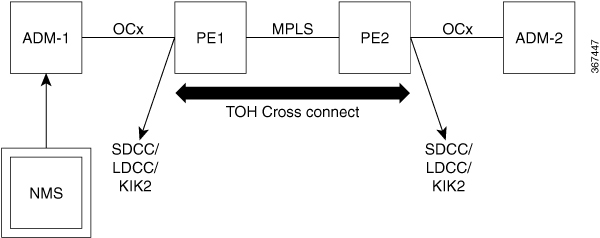Transparent Overhead Tunneling Data Communication Channel Overview
SONET or SDH frame provides data communications channel (DCC) bytes for network element operations such as administration, maintenance, and provisioning.
Each SONET or SDH frame includes two DCCs—Section DCC (SDCC or RS-DCC) and Line DCC (LDCC or MS-DCC). The section and line DCCs are used for transporting management messages between Network Elements (NEs) and between NEs and Network Management System (NMS).
Each SONET or SDH frame uses these DCC bytes in overhead of the frame to carry management information for SONET or SDH networks, or Add or Drop multiplexers (ADMs). These DCC bytes traverse through hop-by-hop between ADMs and perform a path discovery and end-to-end provisioning in SONET or SDH network.
The behavior without DCC tunneling is that the NMS discovers the connected ADM but could not reach the ADM at the remote end of the TDM circuit.
With the introduction of DCC tunneling, the NMS discovers the existing topology and the insertion of ASR nodes are transparent to the DCC bytes. These ASR nodes help to tunnel DCC bytes and the NMS connectivity remains intact.
In the following diagram, the ADM-1 reaches the ADM-2 through transparent overhead (TOH) tunnel that is established between provider edges (PE1 and PE2).
The DCC bytes from ADM-1 reach ADM-2 through the TOH tunnel. Therefore, the NMS could reach the ADM-2 and the topology across ADMs remains intact.

TOH tunneling DCC is supported on the OCx ports for following CEM interface modules:
-
1-port OC-48/STM-16 or 4-port OC-12/OC-3 / STM-1/STM-4 + 12-port T1/E1 + 4-port T3/E3 module
-
1-port OC-192 or 8-port low rate module
-
NCS 4200 1-port OC-192 or 8-port low rate CEM 20G bandwidth module


 Feedback
Feedback